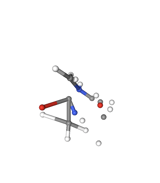I am using an open source python package openmmtools to run a simple molecular simulation problem using the metropolis algorithm.
I first load a default system of particles (alanine-dipeptide in vacuum), add some uniform random disturbance to every position, then let the algorithm run to see if it brings me back to the starting system position.
It looks like the metropolis moves decrease energy, as expected, but do not decrease the euclidean distance of each particle back to its starting position. Euclidean distance is just a sum of all the particle positions at any given state. The following graph is what I see when I measure these quantities. The big initial jump is when I add a disturbance to the positions of every particle in the system. I have even subtracted the mean of the particle positions from each particle to make sure that it isn't just that the entire system is shifting away from the starting position.
Why do the Euclidean distances of each particle not decrease with the energy. In fact, they seem to increase as the simulation continues, which means the particles are growing farther and farther apart, which doesn't seem right. I know the molecule isn't rotating, since I'm drawing the state at each timestep as a 3D scatter plot and can see that it isn't.
I expect is something very silly on my end. I hope the confusion is clear.
Here's the code that gave me this graph, just in case.
from openmmtools import mcmc, testsystems, states, cache
from simtk import openmm
from simtk import unit
import numpy as np
import matplotlib.pyplot as plt
# user parameters
timesteps = 100
draw_init_final_positions = False
plot_distance_energy = True
class AddGaussianVector(mcmc.MetropolizedMove):
def __init__(self, **kwargs):
super(AddGaussianVector, self).__init__(**kwargs)
def _propose_positions(self, initial_positions):
# displacement = unit.Quantity(np.array([1, 1, 1]), initial_positions.unit)
mean, var = 0, .1
x_prop, y_prop, z_prop = np.random.normal(mean, var), np.random.normal(mean, var), np.random.normal(mean, var)
displacement = unit.Quantity(np.array([x_prop, y_prop, z_prop]), initial_positions.unit)
return initial_positions + displacement
def distance(x, correct):
for k in range(3):
x[:, k] -= np.mean(x[:, k])
correct[:, k] -= np.mean(correct[:, k])
noise = np.subtract(x, correct)
return np.sqrt(np.sum(np.square(noise)))
platform = openmm.Platform.getPlatformByName('CUDA')
cache.global_context_cache.platform = platform
# Create the initial state (thermodynamic and microscopic) for an alanine dipeptide system in vacuum.
alanine = testsystems.AlanineDipeptideVacuum()
sampler_state = states.SamplerState(alanine.positions)
thermodynamic_state = states.ThermodynamicState(alanine.system, 300 * unit.kelvin)
e, d = [], []
context_cache = cache.global_context_cache
context, unused_integrator = context_cache.get_context(thermodynamic_state)
sampler_state.apply_to_context(context, ignore_velocities=True)
e.append(thermodynamic_state.reduced_potential(context))
d.append(distance(sampler_state.positions.copy(), sampler_state.positions.copy()))
# draw initial sampler_state
if draw_init_final_positions:
plt.figure(1)
ax = plt.axes(projection='3d')
xdata = sampler_state.positions[:, 0]
ydata = sampler_state.positions[:, 1]
zdata = sampler_state.positions[:, 2]
ax.scatter3D(xdata, ydata, zdata, cmap='Greens')
plt.title('Initial particle conformation')
noise = np.zeros((sampler_state.n_particles, 3))
correct_state = sampler_state.positions.copy()
for i, molecule in enumerate(sampler_state.positions):
# add noise to correct state
noise_low, noise_high = -1, 1
sampler_state.positions[i][0] += unit.quantity.Quantity(value= np.random.uniform(noise_low, noise_high), unit=unit.nanometer)
sampler_state.positions[i][1] += unit.quantity.Quantity(value= np.random.uniform(noise_low, noise_high), unit=unit.nanometer)
sampler_state.positions[i][2] += unit.quantity.Quantity(value= np.random.uniform(noise_low, noise_high), unit=unit.nanometer)
print('Correct_state: ', correct_state)
print('Noisey_state', sampler_state.positions.copy())
print('INITIAL DIST AND ENERGY: {} nm {} energy'.format(d[0], e[0]))
sampler_state.apply_to_context(context, ignore_velocities=True)
e.append(thermodynamic_state.reduced_potential(context))
# Create an update MCMC move that brings us back to the initial configuration.
current_state = sampler_state.positions.copy()
total_accepted, total_proposed = 0, 0
print('TOTAL PARTICLES: ', sampler_state.n_particles)
for ii in range(timesteps):
for jj in range(sampler_state.n_particles):
move = AddGaussianVector(atom_subset=[jj])
move.apply(thermodynamic_state, sampler_state)
if move.n_accepted == 1:
total_accepted += 1
total_proposed += 1
current_state = sampler_state.positions.copy()
# measure euclidean distance
d.append(distance(current_state, correct_state))
# measure energy
sampler_state.apply_to_context(context, ignore_velocities=True)
e.append(thermodynamic_state.reduced_potential(context))
fig, ((ax1),(ax2)) = plt.subplots(2, 1, sharex=True)
ax1.plot(d, label='Euclidean dist')
ax1.set_title('Euclidean Distance to ground state')
ax1.set_ylabel('Euclidean Distance (nm)')
ax2.plot(e, label='Energy')
ax2.set_yscale('log')
ax2.set_title('Energy of conformation')
ax2.set_xlabel('Timesteps')
ax2.set_ylabel('Energy')
ax2.text(2, 10, r'Original Energy {}'.format(e[0]), fontsize=15)
plt.show()
Edit: I've tried visualizing it as per a comment. I'm not sure if anything particular sticks out. The gif begins when the bottom left axis starts at -0.5.






